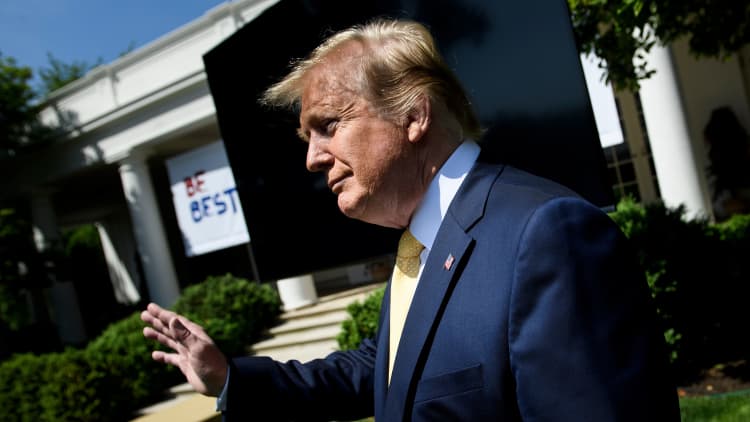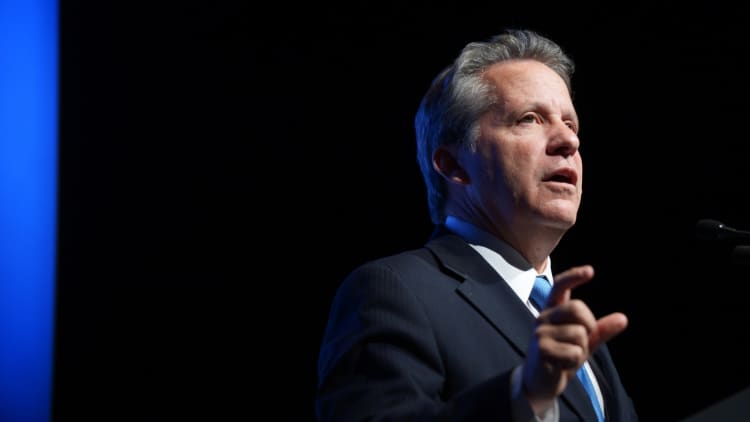
Wall Street strategists urged calm after the latest threats from President Donald Trump after a series of tweets Sunday afternoon. Trump warned that tariffs on $200 billion worth of Chinese goods could rise to 25% on Friday and China was considering canceling this week's trade talks with the U.S. in light of the threat.
The Dow Jones Industrial Average fell as much as 471 points, before rebounding and was last down about 280 points.
"We think it is more likely that the increase will be narrowly avoided and believe the odds of tariffs increasing on Friday are 40%," Goldman Sachs analysts said.

"Unless China walks away from the talks (which is not necessarily the same as Vice Premier Liu canceling his trip but rather having no talks at all), we do not expect an escalation of trade tensions into a trade war," Citi said.
Some analysts differed as to whether Trump's tweets were really a negotiating tactic.
"The timing of the threat suggests it is a tactic designed to increase leverage going into final trade negotiations," UBS said.
But Raymond James wasn't so sure.
"Based upon our conversations with our trade contacts, there appears to be a universal belief that this is not negotiating leverage, but what was almost a done deal last week, has derailed in recent days," wrote analyst Ed Mills in a note to clients.
Here's what strategists say about the U.S.-China tariff feud.
Goldman
"President Trump's announcement that the tariff rate on $200bn of imports from China will rise from 10% to 25% lowers the odds of a successful conclusion to US-China trade talks and raises the odds of further tariff escalation. However, we think it is more likely that the increase will be narrowly avoided and believe the odds of tariffs increasing on Friday are 40%."
Read more about that here.
Citi
"Unless China walks away from the talks (which is not necessarily the same as Vice Premier Liu He canceling his trip but rather having no talks at all), we do not expect an escalation of trade tensions into a trade war. Still, we note that the probability of a 'Trade War today, Trade Deal tomorrow' scenario remains high, with the potential to accelerate US inflation and to extend the timetable for a US-China trade deal into the 2020 electoral year. We are cautiously optimistic on a US-China trade deal in 2Q but with the tariffs-threat to remain as a way to get concessions from China and to enforce the agreement."
UBS
"There are no clear reports indicating what led President Trump to harden his stance on trade talks, with media reports suggesting it was designed to 'send a message' or was in response to China backtracking on previously negotiated points. The timing of the threat suggests it is a tactic designed to increase leverage going into final trade negotiations".
Raymond James
"The progress towards a US-China deal has been up-ended with renewed tariff threats by President Trump (25% tariff on $200 billion in Chinese goods by Friday + 25% on $325 billion more), apparent balks by the Chinese (especially on tech transfers), and the threat of the Chinese delegation canceling this week's round of negotiations. We have previously seen President Trump threaten a new tariff package in the lead up to last year's G20 meeting last year, only to use it as negotiating leverage, leading to speculation that this is President Trump seeking to use the new tariff threats to get a deal across the finish line. Based upon our conversations with our trade contacts, there appears to be a universal belief that this is not negotiating leverage, but what was almost a done deal last week, has derailed in recent days. There is some hope that negotiations could be salvaged, but this situation highlights how tenuous any US-China deal remains."
Oppenheimer
"With that in mind we would not take the President's tweet as referring to an action planned that is set in stone but rather more an expression of frustration as talks have dragged on without reaching a resolution. We expect that any near-term downside moves by the equity markets could be quick to reverse as the US Presidential election of 2020 and a goal of 'Made in China 2025' remain paramount respective agenda items for the leadership of the US and China. In our view these key dates along with the potential considerable economic cost of a protracted trade war (for both countries as well as for their allies and trading partners) will dictate a positive resolution to the current trade dispute sooner than later notwithstanding a near-term 'increase in hostilities.' We suggest that investors consult their shopping lists for stocks that might have 'gotten away' from them in the recent rally should some 'tweet-linked' volatility waft through the markets and push stock prices lower."
RBC
"Our thoughts on Sunday's news that trade talks between the US and China have taken a turn for the worse. The news comes at a time when the US equity market has already become vulnerable to bad news again (and more at risk for a correction in the months ahead) due to excess euphoria among institutional investors and overvaluation. We see some eerie similarities between current conditions in the stock market and those that preceded the S&P 500's peaks in January and September on our sentiment and valuation models. We also think a trade deal with China has been widely anticipated by investors, and a key contributor to the early 2019 rally in US equities. In this context, we see the weekend's developments as a negative catalyst for the market, not only because of where investor expectations have been regarding the deal, but because of the downward earnings revisions that are likely to occur if the tariffs are expanded. In terms of positioning, we see some evidence that a profit-taking mind- set was already taking hold before this weekend's news. We view these steps backwards on the trade deal with China as particularly negative for Industrials (where we've been market weight) and Semis/ Semi Equipment (which we've had a neutral stance on), which have both outperformed strongly this year due partly to improved outlooks on trade. TIMT (which has strongly outperformed in 2019) may also be at risk broadly given the sharp decline in the Nasdaq futures that was in place early Monday morning. On the flip side, we are buyers of defensives today, specifically Consumer Staples (which we've been overweight) and Utilities (we have been market weight, but valuations have recently improved and political risks from both trade and the 2020 election are low)."
Morgan Stanley
"It could be a pressure tactic to speed an agreement on pending issues such as existing tariff removal timing, details related to the enforcement mechanism and industrial subsidies. While we expect a re-escalation would be temporary, as market weakness would help bring both sides back together, any escalation inherently augments uncertainty and further undercuts risk markets, where a Goldilocks outcome was already priced in."
Bank of America
"The immediate market response suggests that the latest escalation of the trade war was a complete surprise to investors. This means that markets could be in for a bumpy ride before a trade deal is reached."
J.P. Morgan
"We think President Trump's comment on China's 'attempt to renegotiate' may reflect his likely frustration with the progress on some structural issues (as China may have resisted on US demands in some key areas); alternatively, China may have pushed hard for the US to roll back on the existing tariffs. As such, the near-term outlook on the trade negotiations has become somewhat unclear, and the next few days would be crucial to watch... Looking back, US-China trade negotiations have been a rather bumpy process. Indeed, back in May last year, shortly after both governments issued a joint statement to avoid an imminent trade war on May 19th, the Trump government indicated on May 29th plans to impose 25% tariff on $50 billion of Chinese imports and curb investment in sensitive technology sectors. Overall, the next couple of days will be crucial to watch. While the escalation of rhetoric and tariff threats by President Trump could be seen as part of the negotiation techniques to pressure China for further concessions, the timeline seems short, with the next stage of tariff hike to take place on Friday May 10th, according to President Trump's tweet messages."
Macquarie
"While we've been complacent about the positive prospect for a trade deal (it has been one basis for our view
that the EUR/USD, GBP/USD, and AUD/USD will slowly rally in H2 2019), we can't presume to have special insights into how the current impasse will resolve itself in the next few weeks. As for the next few days, we suspect that President Trump has put himself in a corner with the Friday deadline, so the risk now is that the escalation of the tariff rate from 10% to 25% will take place on Friday. From that point, if China President Xi Jinping chooses to not make concessions to the US, it will be difficult to overturn his decision, and a stalemate may ensue with traders waiting for the 25% tariffs on the final tranche (USD 325bn) of US imports to be imposed. From then on, it may be the action in the stock market that determined whether one side (presumably, the US) relents. After all, it would be detrimental to President Trump's perception of self-value and re-election prospects is stocks are suffering in 2020."

